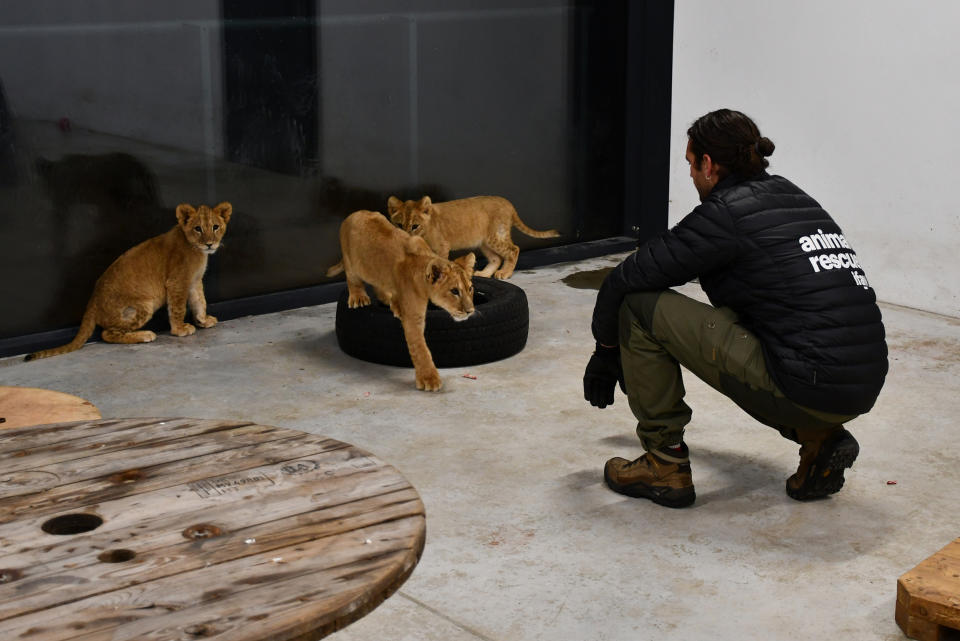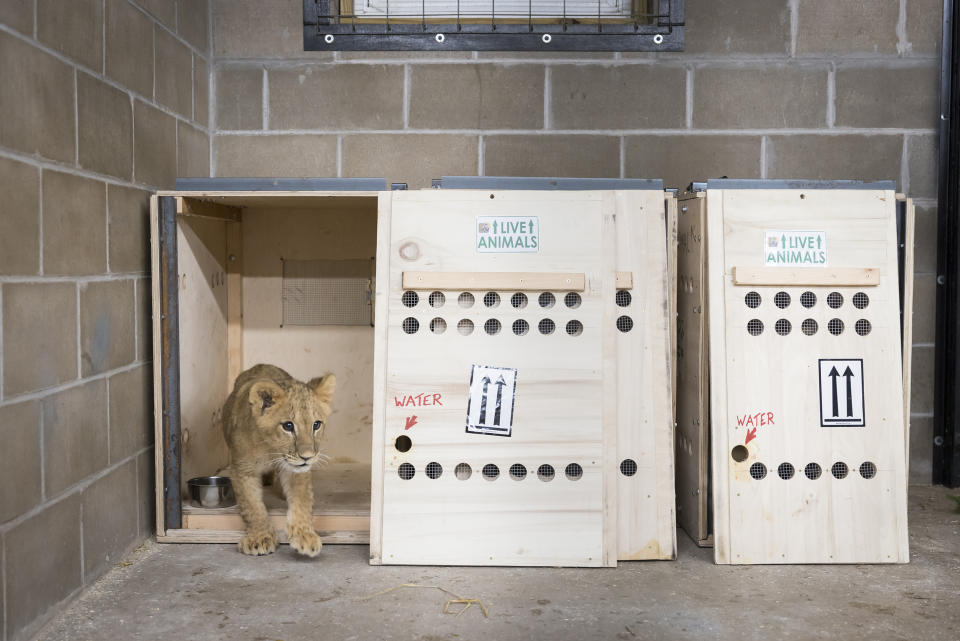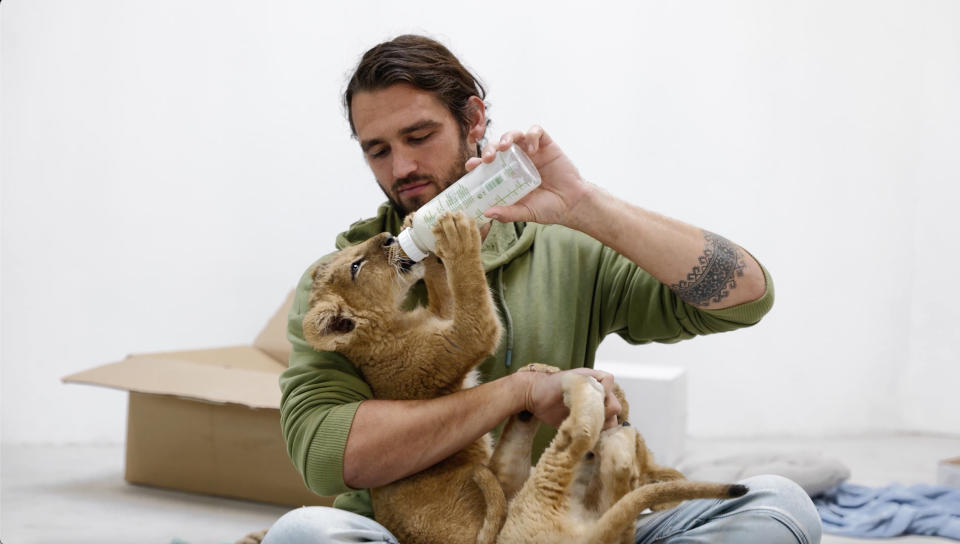4 lion cubs rescued from Ukraine find love and lifetime care in the US
Four lion cubs born at breeding facilities in Ukraine and orphaned during the war have found sanctuary in the United States.
The three female cubs — Stefania, Lesya, Prada — and male cub, Taras, journeyed for 36 hours, fleeing sporadic bombings and drone attacks in their home country to a new life in Minnesota sponsored by the International Fund for Animal Welfare and the Wildcat Sanctuary.
Though the early days of their lives were marred by unknowns and bewildering conditions, the cubs’ arrival marks a new chapter in their lives, one filled now with certitude and comfort.
The cubs will be provided lifetime care ( $10,000 per year per cub for 20 years) by the Wildcat Sanctuary.
“It really was a team effort,” Meredith Whitney, who serves as IFAW’s wildlife rescue program manager, tells TODAY.com. “It’s just been a phenomenal multinational pulling together. That has been really nice to see.”
The cubs are thought to have come from two litters. Prada — the oldest of the cubs — was born at a breeding facility in Ukraine's capital, Kyiv, while the other three came from Odesa and are believed to have the same mother.
In September, an IFAW-sponsored veterinarian named Dr. Andrew Kushnir contacted the organization about the cubs.
On Nov. 28, the cubs took a nine-hour flight from Poland to Chicago. Once they cleared customs, they were loaded into a heated van and rode eight hours to the sanctuary in Minnesota. They arrived in the middle of the night on Nov. 29.

Whitney says the cubs are thriving in their new homes.
So far, they are all in good health, though a complete evaluation, which will include X-rays and bloodwork, will be conducted by veterinarians once the cubs have settled in.
“I don’t anticipate they’re going to find anything in (the tests) because they do all appear to be very healthy little babies,” Whitney says, adding that they’re already coming into their distinct personalities.
“Taras is the male, and he is a very typical lion male. He likes to just sit back and watch what the girls are doing,” Whitney says. “Just very kind of chill and brave little dude.”
Despite being born outside the three cubs' litter, Prada has embraced her adopted siblings.
“She immediately went to them and was trying to groom them, was trying to, you know, headbutt like cats do,” Whitney says of the first night Prada and the other cubs were introduced to each other in Minnesota. “By the second day, they were all in a big cuddle puddle together."
Of the two sibling females, Lesya is the smallest.
“She’s a screamer. She is just a vocal little (cub). She will talk to you about everything. She just wants you to know whatever it is she wants you to know,” Whitney explains. “She’s always complaining about something or telling you something. So we actually can tell the two girls apart just strictly based on behavior.”

Stefania, meanwhile, has emerged as the laid-back female cub.
“We did notice that when (the three younger cubs) first started interacting with Prada — that Prada would get overwhelmed at times and kind of withdraw and go hide, and Stefania would go check on her,” Whitney recalls.
Shannon Walajtys, director of disaster response and risk reduction at IFAW, says their work is far from done.
The four cubs and the breeding facilities they came from highlight a dire issue not just in Ukraine but around the world.
Beyond exploiting animals and violating the rule of law, the illicit wildlife trade complicates and hinders what animal welfare organizations and conservation charities can do when disasters — be it armed conflict, political crisis, natural forces or weather — unfold.

“There is a big problem in Ukraine with illegal breeding for the illicit pet trade,” Whitney adds. “So there were just a ton of animals in very inappropriate housing even before the war, and now the war has created more vulnerabilities.”
According to Humane Society International, thousands of wild and exotic animals live in zoos, wildlife rescues and within private ownership and sanctuaries throughout the country.
IFAW has no contact information for the anonymous breeder who surrendered Stefania, Lesya and Taras to a rescue center in Odesa.
“They were told that these lion cubs would be showing up at the train station,” Whitney explains. “And (the rescue) went and just picked up a duffel bag, and inside the duffel bag was a cardboard box with these lion cubs in it with no one really accompanying them.”

Before the cubs were rescued and as IFAW became attuned to the likelihood of a conflict breaking out, Walajtys says the organization got to work assessing what aid in Ukraine would look like.
In particular, they knew they’d be dealing with zoos and wildlife sanctuaries. Then, there were the markets where wildlife crime was taking place. In their estimations, however, the unknown variables spelled trouble.
“That’s when we recognized the amazing number of captive animals, captive wild animals, and whether again, whether they were in zoos, wildlife sanctuaries for lifetime care, or wildlife rehabilitation centers, trying to get healthy to be released back to the wild,” she explains. “We were also finding a number of breeders of wild animals.”
Alarming questions emerged.
“What’s going to happen if A) borders close and if B) resources suddenly become so scarce that there’s competition between wild animals, companion animals, livestock humans?” Walajtys asks.
Celine Sissler-Bienvenu, the senior program officer of European disaster response and risk reduction for IFAW, says that Ukraine is a reminder that when crises arise, it’s not just humans who are affected.
“These exotic pets don’t have any areas to go,” she explains. “So they’re abandoned." Sissler-Bienvenu hopes that nongovernmental organizations like IFAW can provide support to Ukrainian authorities and help the animals going out.
Despite all the challenges, there's one message she thinks the public should take away from this: "It’s important not to have exotic pets."
Related:
This article was originally published on TODAY.com

